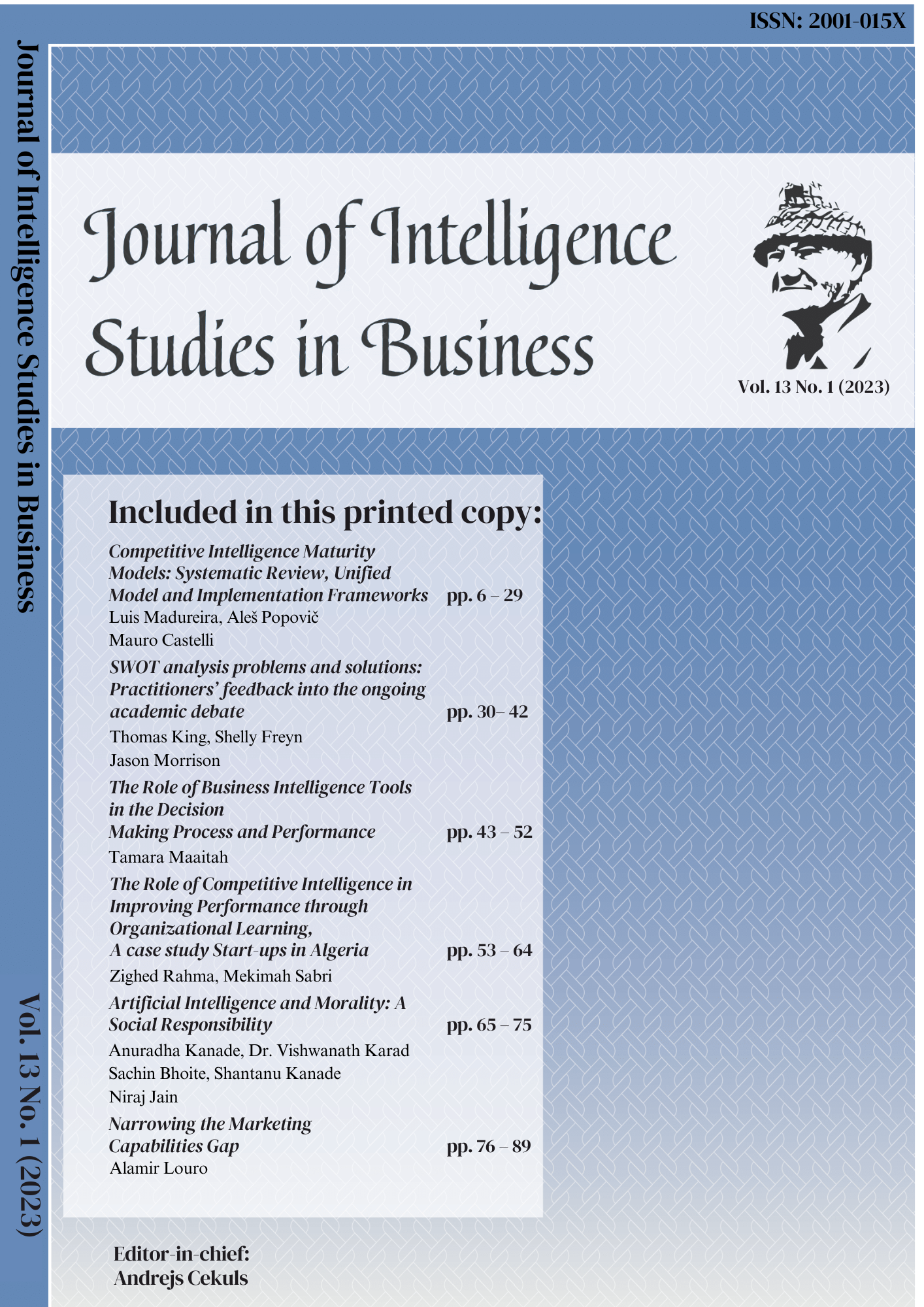SWOT analysis problems and solutions: Practitioners’ feedback into the ongoing academic debate
DOI:
https://doi.org/10.37380/jisib.v13i1.989Keywords:
academic-practitioner divide, strategic management tools, SWOTAbstract
The literature on SWOT is characterized by a debate among academics who have identified problems and proposed solutions for the strategic management tool, yet little research to date has captured practitioners’ perspectives. Recent literature indicates that SWOT is still the most popular strategic management tool among competitive intelligence (CI) professionals. The purpose of this study is to bridge this academic-practitioner divide in the SWOT literature by conducting a cross-sectional survey that gathers practitioners’ feedback regarding whether they are experiencing the problems or employing the solutions proposed by academia. A survey was distributed via LinkedIn to collect data from CI and other business professionals who conduct SWOT in the workforce. The findings confirm that practitioners experience select problems identified by the literature. Specifically, they may have too many factors per SWOT category, may be defining factors with ambiguous and unclear words, and may not have a means for resolving conflicts when factors fall in multiple categories (e.g., opportunity and threat). The findings also indicate that practitioners may not be consistently conducting SWOT as a structured business process, as proposed in the literature. The feedback provided by CI and other business professionals aids in closing the academic-practitioner divide by more clearly identifying persistent issues with SWOT and creating valuable and actionable insights that will drive the continual improvement of this popular strategic management tool.
References
Connell, J., Carlton, J., Grundy, A., Buck, E. T., Keetharuth, A. D., Ricketts, T., Barkham, M., Robotham, D., Rose, D., and Brazier, J. (2018) “The Importance of content and face validity in instrument development: lessons learnt from service users when developing the Recovering Quality of Life measure (ReQoL)”, Quality of Life Research, Vol. 27, pp.1893-1902. DOI: https://doi.org/10.1007/s11136-018-1847-y
Clardy, A. (2013). “Strengths vs. Strong Position: Rethinking the Nature of SWOT Analysis”, Modern Management Science & Engineering, Vol. 1 No. 1, pp.100-122. DOI: https://doi.org/10.22158/mmse.v1i1.54
Cardoso, E., Labunets, K., Dalpiaz, F., Mylopoulos, J., and Giorgini, P. (2016). “Modeling Structured and Unstructured Processes: An Empirical Evaluation”, Comyn-Wattiau, I., Tanaka, K., Song, IY., Yamamoto, S., Saeki, M. (Ed.), Conceptual Modeling, Springer International Publishing AG, New York, NY, pp.347-361. DOI: https://doi.org/10.1007/978-3-319-46397-1_27
Denrell, J., Fang, C., and Winter, S. G. (2003). “The economics of strategic opportunity”, working paper [No.2003/10], Laboratory of Economics and Management Sant’Anna School of Advanced Studies, Pisa, Italy, July. DOI: https://doi.org/10.1002/smj.341
[Author] and Hoffman, F. (2023). “Competitive intelligence in an AI world: Practitioners’ thoughts on technological advances and the educational needs of their successors.” Journal of Intelligence Studies in Business, Vol. 12 No. 3, pp. 6-17. https://seojs-dev.lu.lv/index.php/JISIB/article/view/893 DOI: https://doi.org/10.37380/jisib.v12i3.893
Frost, F. A. (2003). “The use of strategic tools by small and medium-sized enterprises: an Australasian study” Strategic Change, Vol. 12 No. 1, pp.49-62. DOI: https://doi.org/10.1002/jsc.607
Fulton, B. (2016). “Organizations and survey research: Implementing response enhancing strategies and conducting nonresponse analyses.” Sociological Methods & Research, Vol. 47 No. 2, pp.1-37. DOI: https://doi.org/10.1177/0049124115626169
Ghazinoory, S., Abdi, M., and Azadegan-Mehr, M. (2011). “SWOT Methodology: A State-of-the-Art Review for the Past, a Framework for the Future”, Journal of Business Economics and Management, Vol. 12 No. 11, pp.24-48. DOI: https://doi.org/10.3846/16111699.2011.555358
Gürel, E. and Tat, M. (2017) “SWOT analysis: A theoretical review”, The Journal of International Social Research, Vol. 10. No. 51, pp.994-1006. DOI: https://doi.org/10.17719/jisr.2017.1832
Helms, M. M., and Nixon, J. (2010). “Exploring SWOT analysis - Where are we now? A review of academic research from the last decade”, Journal of Strategy and Management, Vol. 3, No. 3, pp.215-251. DOI: https://doi.org/10.1108/17554251011064837
Hill, T. and Westrbook, R. (1997). “SWOT analysis: It’s time for a product recall”, Long Range Planning, Vol. 30, No. 1, pp.46-52. DOI: https://doi.org/10.1016/S0024-6301(96)00095-7
Hunt, S. D., and Derozier, C. (2004). “The normative imperatives of business and marketing strategy: grounding strategy in resource-advantaged theory.” Journal of Business & Industrial Marketing, Vol. 19 No. 1, pp.5-22. Jareño, F., and Negrut, L. (2016). “US Stock Market and Macroeconomic Factors”, The Journal of Applied Business Research, Vol. 32, No. 1 pp.325-340. DOI: https://doi.org/10.1108/08858620410516709
Jaworski, B. J. (2011). “On Managerial Relevance”, Journal of Marketing, Vol. 75 No. 4, pp.211-223. DOI: https://doi.org/10.1509/jmkg.75.4.211
Kay, N. M., Leih, S., and Teece, D. J. (2018). “The role of emergence in dynamic capabilities: a restatement of the framework and some possibilities for future research”, Industrial and Corporate Change, Vol. 27 No. 4, pp.623-638. DOI: https://doi.org/10.1093/icc/dty015
Kraaijenbrink, J., Spender, J. C., and Groen, A. (2009). “The resource-based view: A review and assessment of its critiques”, Journal of Management, Vol. 36 No. 1, pp.349-372. DOI: https://doi.org/10.1177/0149206309350775
Maholtra, N. K. (2012). Basic Marketing Research (4th. ed). Upper Saddle River, NJ: Pearson Education, Inc.
Porter, M. E. (1980). Competitive Strategy: Techniques for Analyzing Industries and Competitors, The Free Press, New York, NY.
Priem, R. and Butler, J. (2001). “Is the Resource-Based “View” a Useful Perspective for Strategic Management Research?” Academy of Management Review, Vol. 26 No. 1, pp.22-40. DOI: https://doi.org/10.5465/amr.2001.4011928
Qehaja, A. B., Kutllovci, E., and Pula, J. S. (2017). “Strategic Management Tools and Techniques Usage: A Qualitative Review”, Acta Universitatis Agriculturae et Silviculturae Mendelianae Brunenis, Vol. 65 No. 2, pp.585-600. DOI: https://doi.org/10.11118/actaun201765020585
Ratnasingham, P. (2006). “A SWOT analysis for B2C e-commerce: The case of Amaozn.com” International Journal of Cases on Electronic Commerce (IJCEC), Vol. 2 No. 1, pp.1-22. DOI: https://doi.org/10.4018/jcec.2006010101
Reichert, M. and Weber, B. (2012). Enabling Flexibility in Process-Aware Information Systems - Challenges, Methods, Technologies. Springer Berlin, Hieldelberg, Germany. DOI: https://doi.org/10.1007/978-3-642-30409-5
Schinasi, G. J. (2004). “Defining Financial Stability”, Working Paper No. 04/187, International Monetary Fund, Washington, D.C., October. DOI: https://doi.org/10.5089/9781451859546.001
Teece, D. J. (2007). “Explicating dynamic capabilities: the nature and microfoundations of (sustainable) enterprise performance”, Strategic Management Journal, Vol. 28, pp.1319-1350. U.S. Bureau of Economic Analysis. “Gross Private Domestic Investment [GPDI]”, available at https://fred.stlouisfed.org/series/GPDI (accessed 17 March 2023). U.S. Bureau of Economic Analysis. “Personal Consumption Expenditures [PCE]”, available at https://fred.stlouisfed.org/series/PCE (accessed 15 March 2023). DOI: https://doi.org/10.1002/smj.640
U.S. Bureau of Labor Statistics. “Unemployment Rate [UNRATE]” available at https://fred.stlouisfed.org/series/UNRATE (accessed 17 March 2023).
Valentin, E. K. (2001). “Swot analysis from a Resource-Based View”, Journal of Marketing Theory and Practice, Vol. 9 No. 2, pp.54-69. DOI: https://doi.org/10.1080/10696679.2001.11501891
Weihrich, H. (1982). “The TOWS Matrix a Tool for Situational Analysis”, Long Range Planning, Vol. 15 No. 2, pp.54-66. DOI: https://doi.org/10.1016/0024-6301(82)90120-0
Wheaton, K. and Beerbower, M. (2006). “Towards a New Definition of Intelligence”, Stanford Law & Policy Review Vol. 17, pp.319 – 330. World Bank. “Inflation, consumer prices for the United States [FPCPITOTLZGUSA]” available at https://fred.stlouisfed.org/series/FPCPITOTLZGUSA (accessed 17 March 2023).
Downloads
Published
Issue
Section
License
Copyright (c) 2023 Journal of Intelligence Studies in Business

This work is licensed under a Creative Commons Attribution-NonCommercial-NoDerivatives 4.0 International License.
Authors who publish with this journal agree to the following terms:
- Authors retain copyright and grant the journal right of first publication with the work simultaneously licensed under a Creative Commons Attribution License that allows others to share the work with an acknowledgement of the work's authorship and initial publication in this journal.
- Authors are able to enter into separate, additional contractual arrangements for the non-exclusive distribution of the journal's published version of the work (e.g., post it to an institutional repository or publish it in a book), with an acknowledgement of its initial publication in this journal.
- Authors are permitted and encouraged to post their work online (e.g., in institutional repositories or on their website) prior to and during the submission process, as it can lead to productive exchanges, as well as earlier and greater citation of published work (See The Effect of Open Access).








